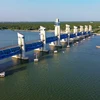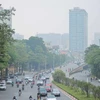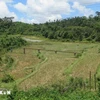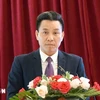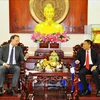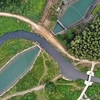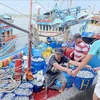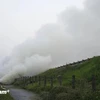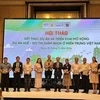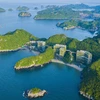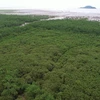Ambassador Le Hoai Trung, Permanent Representative of Vietnam to the United Nations, shared Vietnam’s experience on disaster preparedness at the launch of IASC/ODI Report “Dare to Prepare: Taking Risks Seriously” on February 27. Following is the full text of his presentation.
“Let me first thank the IASC and ODI for inviting me to this important event. I appreciate the opportunity to share some thoughts on the issue of disaster preparedness and in particular what my country, Vietnam , has been doing in this regard.
The topic of disaster preparedness that IASC and ODI have chosen for this report is highly relevant. This is a matter of vital importance for the sustainable development of any nation. Therefore, I welcome the launch of the report today as an effort to increase understanding about preparedness, particularly at the time when the United Nations is working on the post-2015 development agenda and the new Sustainable Development Goals.
The report sends many important messages, highlighting the need to invest in preparedness. One dollar investment in preparedness can help save 3-5 dollars in response. And more importantly, investment in preparedness will save human lives, which we all would agree cannot be monetised.
But as it stands now, mobilising resources for response ironically is easier than for preparedness. I therefore concur with the report’s recommendations aimed at increasing financing for preparedness, with a combination of global, regional and national financing mechanisms.
To give us some more persepective, let me share with you Vietnam ’s experience as a disaster-prone country. Natural disasters are not something new to us. For thousands of years, the Vietnamese nation has fought two enemies: foreign aggression and natural disasters. Vietnamese legends tell the story of the Mountain God conquering the Flood God to save the livelihoods of the people.
According to the World Bank, Vietnam is ranked as the seventh most exposed country in the world to multiple natural hazards including floods, tropical cyclones (typhoon), tornados, landslides and droughts. An estimated 59 percent of the total area of the country and 71 percent of the population are exposed to cyclones and floods.
Over the last 30 years, disasters have been a major cause of fatalities, injury and economic losses, according to World Bank and UNDP estimates, totalling about 1.0 – 1.5 percent GDP. But current challenges of disaster risks and impacts are likely to be further exacerbated by global climate change. In 2013 alone, Vietnam was hit by no less than 15 tropical cyclones. Therefore, the Government of Vietnam takes disaster preparedness very seriously.
In 2007, the Government endorsed the National Strategy for Disaster Risk Management, to include more than 19 types of natural hazards in its disaster definitions. A new Disaster Law passed last year goes further and, for the first time, covers the whole disaster management cycle, including preparedness, response and post-disaster recovery. The law strengthens the coordination structures for all phases of the disaster cycle and allows provinces to set up disaster management funds empowering them to promptly address the humanitarian and preparedness capacity gaps. The Law also draws on the principle of four “on-the-spot”, namely on-the-spot command, on-the-spot human resources, on-the-spot logistics and on-the-spot facilities.
A key lesson learned to date is the importance of investing in legislative and policy frameworks that promote effective disaster risk management and climate change adaptation, not just post-disaster relief. These efforts need to be multi-hazard and multi-sectoral and should involve all parts of the Government and key stakeholders, like the Vietnam Red Cross, Farmers’ Union, Women’s Union, Youth Union … These efforts should also be based on sound scientific knowledge and risk analysis. Evidence from Vietnam ’s experiences with Typhoon Haiyan in 2013 suggests that, much like in the Philippines , Vietnam was at high risk of a similar super-typhoon and storm surge. The Government of Vietnam has been rigorously assessed the risk of these extremes to invest in emergency preparedness in order to minimise losses of life and property.
In these endeavours, Vietnam has received invaluable support from the United Nations, members of the IASC like FAO, UNDP, and many bilateral partners, to help us bring current systems in line with the provisions of the law. A good example is support provided for the National Community Based Disaster Risk Management Program which is being rolled out and will cover more than two-thirds of the country by 2020.
More work remains to be done, particularly with regards to how we manage and transfer financial risk, and how key building and other standards need to be made more stringent in light of climate change. Policy also needs to be backed up by effective enforcement. There is also a need to strengthen cost-benefits analysis on investment in vulnerable areas and to draw attention of decision-makers and businesses to consider disaster risk reduction (DRR) as part of their investment decisions. Closer links between DRR and planning and development processes are also needed. Work is underway in many of these areas, and Vietnam is committed to moving forward in implementing the newly adopted law and further enhancing resilience at all levels. We look forward to the continued support of the UN system and other development partners.
About IASC and ODI
The Inter-Agency Standing Committee (IASC) is a unique inter-agency forum for coordination, policy development and decision-making involving the key UN and non-UN humanitarian partners. The IASC was established in June 1992 in response to United Nations General Assembly Resolution 46/182 on the strengthening of humanitarian assistance. General Assembly Resolution 48/57 affirmed its role as the primary mechanism for inter-agency coordination of humanitarian assistance.
The Overseas Development Institute (ODI) is the UK 's leading independent think tank on international development and humanitarian issues. The ODI’s mission is to inspire and inform policy and practice which lead to the reduction of poverty, the alleviation of suffering and the achievement of sustainable livelihoods in developing countries. We do this by locking together high quality applied research, practical policy advice, and policy-focused dissemination and debate. We work with partners in the public and private sectors, in both developing and developed countries.”-VNA
“Let me first thank the IASC and ODI for inviting me to this important event. I appreciate the opportunity to share some thoughts on the issue of disaster preparedness and in particular what my country, Vietnam , has been doing in this regard.
The topic of disaster preparedness that IASC and ODI have chosen for this report is highly relevant. This is a matter of vital importance for the sustainable development of any nation. Therefore, I welcome the launch of the report today as an effort to increase understanding about preparedness, particularly at the time when the United Nations is working on the post-2015 development agenda and the new Sustainable Development Goals.
The report sends many important messages, highlighting the need to invest in preparedness. One dollar investment in preparedness can help save 3-5 dollars in response. And more importantly, investment in preparedness will save human lives, which we all would agree cannot be monetised.
But as it stands now, mobilising resources for response ironically is easier than for preparedness. I therefore concur with the report’s recommendations aimed at increasing financing for preparedness, with a combination of global, regional and national financing mechanisms.
To give us some more persepective, let me share with you Vietnam ’s experience as a disaster-prone country. Natural disasters are not something new to us. For thousands of years, the Vietnamese nation has fought two enemies: foreign aggression and natural disasters. Vietnamese legends tell the story of the Mountain God conquering the Flood God to save the livelihoods of the people.
According to the World Bank, Vietnam is ranked as the seventh most exposed country in the world to multiple natural hazards including floods, tropical cyclones (typhoon), tornados, landslides and droughts. An estimated 59 percent of the total area of the country and 71 percent of the population are exposed to cyclones and floods.
Over the last 30 years, disasters have been a major cause of fatalities, injury and economic losses, according to World Bank and UNDP estimates, totalling about 1.0 – 1.5 percent GDP. But current challenges of disaster risks and impacts are likely to be further exacerbated by global climate change. In 2013 alone, Vietnam was hit by no less than 15 tropical cyclones. Therefore, the Government of Vietnam takes disaster preparedness very seriously.
In 2007, the Government endorsed the National Strategy for Disaster Risk Management, to include more than 19 types of natural hazards in its disaster definitions. A new Disaster Law passed last year goes further and, for the first time, covers the whole disaster management cycle, including preparedness, response and post-disaster recovery. The law strengthens the coordination structures for all phases of the disaster cycle and allows provinces to set up disaster management funds empowering them to promptly address the humanitarian and preparedness capacity gaps. The Law also draws on the principle of four “on-the-spot”, namely on-the-spot command, on-the-spot human resources, on-the-spot logistics and on-the-spot facilities.
A key lesson learned to date is the importance of investing in legislative and policy frameworks that promote effective disaster risk management and climate change adaptation, not just post-disaster relief. These efforts need to be multi-hazard and multi-sectoral and should involve all parts of the Government and key stakeholders, like the Vietnam Red Cross, Farmers’ Union, Women’s Union, Youth Union … These efforts should also be based on sound scientific knowledge and risk analysis. Evidence from Vietnam ’s experiences with Typhoon Haiyan in 2013 suggests that, much like in the Philippines , Vietnam was at high risk of a similar super-typhoon and storm surge. The Government of Vietnam has been rigorously assessed the risk of these extremes to invest in emergency preparedness in order to minimise losses of life and property.
In these endeavours, Vietnam has received invaluable support from the United Nations, members of the IASC like FAO, UNDP, and many bilateral partners, to help us bring current systems in line with the provisions of the law. A good example is support provided for the National Community Based Disaster Risk Management Program which is being rolled out and will cover more than two-thirds of the country by 2020.
More work remains to be done, particularly with regards to how we manage and transfer financial risk, and how key building and other standards need to be made more stringent in light of climate change. Policy also needs to be backed up by effective enforcement. There is also a need to strengthen cost-benefits analysis on investment in vulnerable areas and to draw attention of decision-makers and businesses to consider disaster risk reduction (DRR) as part of their investment decisions. Closer links between DRR and planning and development processes are also needed. Work is underway in many of these areas, and Vietnam is committed to moving forward in implementing the newly adopted law and further enhancing resilience at all levels. We look forward to the continued support of the UN system and other development partners.
About IASC and ODI
The Inter-Agency Standing Committee (IASC) is a unique inter-agency forum for coordination, policy development and decision-making involving the key UN and non-UN humanitarian partners. The IASC was established in June 1992 in response to United Nations General Assembly Resolution 46/182 on the strengthening of humanitarian assistance. General Assembly Resolution 48/57 affirmed its role as the primary mechanism for inter-agency coordination of humanitarian assistance.
The Overseas Development Institute (ODI) is the UK 's leading independent think tank on international development and humanitarian issues. The ODI’s mission is to inspire and inform policy and practice which lead to the reduction of poverty, the alleviation of suffering and the achievement of sustainable livelihoods in developing countries. We do this by locking together high quality applied research, practical policy advice, and policy-focused dissemination and debate. We work with partners in the public and private sectors, in both developing and developed countries.”-VNA

